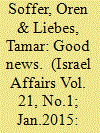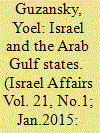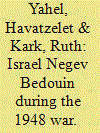|
|
|
Sort Order |
|
|
|
Items / Page
|
|
|
|
|
|
|
| Srl | Item |
| 1 |
ID:
137043


|
|
|
|
|
| Summary/Abstract |
The article describes the Artsbridge approach to building partnership and mutual understanding between Israeli and Palestinian teenagers. Intensive training in the US and partnership with NGOs in Israel and the West Bank cultivate qualities necessary for effective future leadership and cooperation. The training model integrates art instruction, expressive therapy, training in reflective dialogue, and informal recreational activity. This integrated approach addresses the effects of living in protracted conflict on the development of flexibility, creativity, empathy, and inter-subjectivity necessary for building post-conflict society.
|
|
|
|
|
|
|
|
|
|
|
|
|
|
|
|
| 2 |
ID:
137037


|
|
|
|
|
| Summary/Abstract |
This article analyses income inequality in Israel and the role of ethnicity in creating or explaining it. It shows that in spite of relatively large ‘raw’ disparities in mean incomes across the ethnic groups, when controlling for other non-ethnic factors it is not generally the case that Arabs underperform in the Israeli labour markets compared with Jews, and in some cases Arabs outperform Jews, especially for men. Returns on education also do not appear to be lower for Arabs, other things being equal. In spite of the stereotypes, Ashkenazim generally do not outperform Mizrahim, or at most do so to a very small degree. The main ‘advantaged’ ethnic group are the native-born sabra Israelis. The main ‘disadvantaged’ demographic group are recent immigrants. Somewhat surprisingly, Ethiopians do not underperform compared with other immigrants, other things being equal.
|
|
|
|
|
|
|
|
|
|
|
|
|
|
|
|
| 3 |
ID:
137041


|
|
|
|
|
| Summary/Abstract |
The image of the Israeli soldier has transmuted over time. This is particularly true when examining this image in Israeli media. As media reflects social changes, understanding the development of the image of the Israeli soldier in Israeli media may be indicative of wider transformations. During the 1982 Lebanon War the Israeli soldier was identified chiefly as a tough, masculine figure; a warrior. In the 1990s, there was a gradual transformation into a more vulnerable image: a scared, fragile survivor, who wants to return home in one piece. Conversely, during the first decade of the twenty-first century, the framing of the Israeli soldier becomes more complex, with both images present in the media. However, despite the fact both images appear, during this final period the ‘warrior’ image receives more visibility. Using theoretical literature from the fields of communications and civil–military–media relations, and covering two major Israeli news publications – Yediot Aharonot and Haaretz – this article traces the image of the Israeli soldier from the 1982 Lebanon War (1982) to Operation Cast Lead (2008–9).
|
|
|
|
|
|
|
|
|
|
|
|
|
|
|
|
| 4 |
ID:
137040


|
|
|
|
|
| Summary/Abstract |
The Carmel Newsreels were screened in cinemas for more than a decade before and for two decades after the establishment of the State of Israel (1935–70). The newsreels were of prime importance in creating and documenting visual representations of everyday life in the burgeoning Jewish state, particularly in view of the late introduction of television (1968) to Israel. This article examines the place of the newsreels in the Hebrew language media on the eve of the establishment of the state, particularly the division of roles between newspapers and the filmed newsreels. It argues that for various reasons, including a range of technological and contextual constraints and the fact that they were screened in cinemas in conjunction with feature films as part of a programme of entertainment, the newsreels were for the most part upbeat, celebrating the achievements of the Zionist project. They did not offer an alternative to the print press, but rather added a visual, in the main positive, perspective to the print newspapers.
|
|
|
|
|
|
|
|
|
|
|
|
|
|
|
|
| 5 |
ID:
137042


|
|
|
|
|
| Summary/Abstract |
The Gulf states have preferred to adhere to the basic Arab position vis-à-vis Israel, albeit supplementing such positions with their own, sometimes significant, adjustments. However the common threat from Iran has become a source of rapprochement between them and Israel, even if the establishment of ‘normal relations’ remains dependent on progress in the peace process between Israel and the Palestinians, Arab consensus and GCC politics. The two sides, each with their own logic, seem to prefer to maintain a dual policy that on the one hand accepts the lack of normalization but on the other hand maintains active, albeit tacit, ties.
|
|
|
|
|
|
|
|
|
|
|
|
|
|
|
|
| 6 |
ID:
137039


|
|
|
|
|
| Summary/Abstract |
While much has been written on various aspects of the 1948 War, the story of the Negev Bedouins' role and their relations with the newly formed Jewish state has drawn little attention. This article focuses on a short but important episode in the establishment of Israeli–Bedouin relations by examining the Negev Bedouin involvement in the 1948 War, predominantly on the side of the Arab armies, and the circumstances of their departure. Its findings contradict previous academic narratives and baseless statements regarding Bedouin–Israeli relations, including unfulfilled promises by the Israeli authorities to recognize Bedouin claims to land rights.
|
|
|
|
|
|
|
|
|
|
|
|
|
|
|
|
| 7 |
ID:
137038


|
|
|
|
|
| Summary/Abstract |
This article examines the emergence of a vocal and influential pro-Palestinian campaign within the Labour Party in the 1960s and 1970s. In particular, it focuses upon the work of the Labour Middle East Council established by Christopher Mayhew in 1969. The article argues that Mayhew succeeded in laying the foundations for a network of pro-Palestinian organizations in the 1980s but that the note of anti-Zionist radicalism which he introduced provided a foothold for more controversial forms of activism within the mainstream Labour movement.
|
|
|
|
|
|
|
|
|
|
|
|
|
|
|
|
|
|
|
|
|